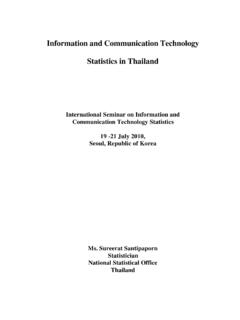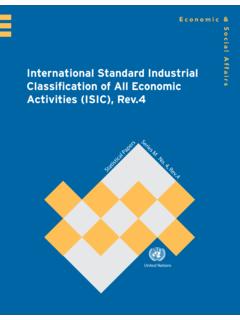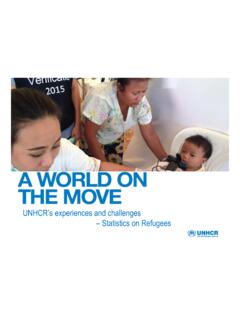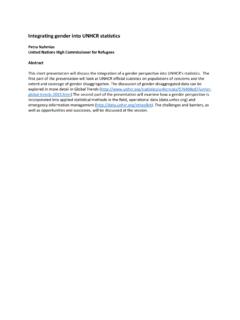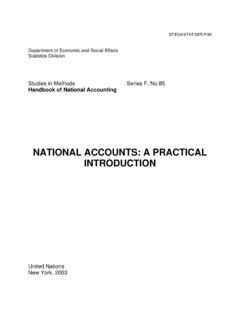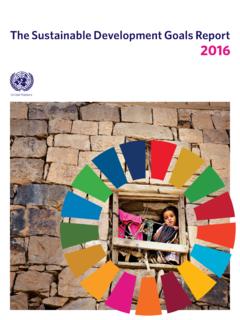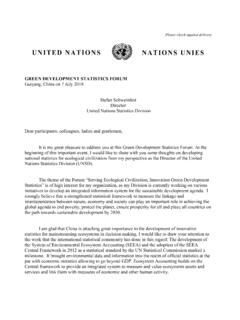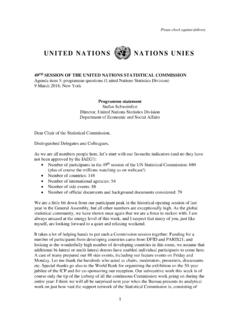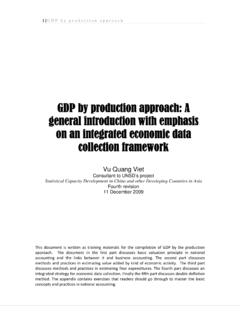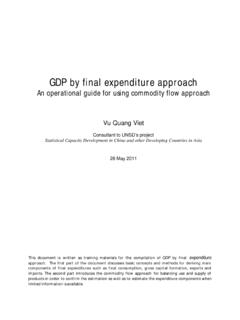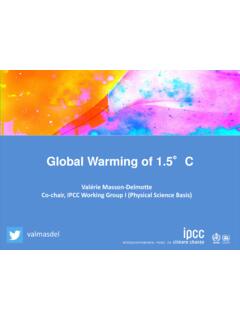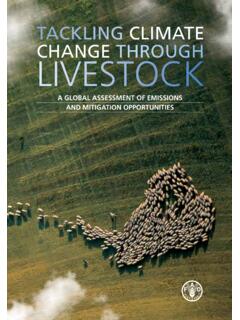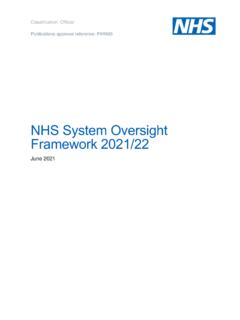Transcription of The World’s Women 2015 - United Nations
1 The world s Women 2015 Trends and StatisticsPrinted at the United Nations , New York15-04629 ISBN 978 - 92-1-16159 4 - 4 The world s Women 2015 Trends and StatisticsUnited NationsThe world 's Women 2015 Trends and StatisticsasdfUnited NationsNew York, 2015 Department of Economic and Social AffairsST/ESA/ T/ E SA /S TAT/SER . K /20 2015 United NationsAll rights reserved worldwideRequests to reproduce excerpts or to photocopy should be addressed to the Copyright Clearance Center at other queries on rights and licenses, including subsidiary rights, should be addressed to: United Nations Publications, 300 East 42nd Street, New York, NY 10017, United States of : website: Nations publication issued by the Department of Economic and Social Affairs (DESA)ISBN: 978 -92-1-16159 4 - 4 e-ISBN: 978-92-1-057371-9 Sales No. DOI: Nations Department of Economic and Social AffairsThe Department of Economic and Social Affairs of the United Nations Secretariat is a vital interface between global policies in the economic, social and environmental spheres and national action.
2 The Department works in three main interlinked areas: (i) it compiles, generates and analyses a wide range of economic, social and environmental data and information on which States Members of the United Nations draw to review common problems and to take stock of policy options; (ii) it facilitates the negotiations of Member States in many intergovernmental bodies on joint courses of action to address ongoing or emerging global challenges; and (iii) it advises interested Governments on the ways and means of translating policy frameworks developed in United Nations conferences and summits into programmes at the country level and, through technical assistance, helps build national designations employed and the presentation of the material in this publication do not imply the expression of any opinion whatsoever on the part of the Secretariat of the United Nations con-cerning the legal status of any country, territory, city or area or of its authorities, or concerning the delimitation of its frontiers or boundaries.
3 The term country as used in the text of this publication also refers, as appropriate, to territories and areas. Since there is no established convention for the designation of developed and developing countries or areas in the United Nations system, this distinction is made for the purposes of statistical and analytical purposes only and does not neces-sarily express a judgment about the stage reached by a particular country or region in the develop-ment process. Mention of the name of any company, organization, product or website does not imply endorsement on the part of the United citation: United Nations , 2015 . The world 's Women 2015 : Trends and Statistics. New York: United Nations , Department of Economic and Social Affairs, Statistics Division. Sales No. from the Secretary-General The world s Women 2015 : Trends and Statistics comes as the international community marks the twentieth anniversary of the landmark Beijing Declaration and Platform for Action and looks forward to the adoption of sustainable development goals to guide our global fight against poverty through the year s advancement, equality and empowerment, so central to progress on the Millennium Development Goals, remain indispensable to report confirms that the lives of Women have improved in a number of areas over the last two decades but the pace has been slow and uneven across regions as well as within and among commend this publication to governments, researchers, scholars, non-governmental organiza-tions and citizens around the world .
4 I trust that all will use the valuable information in these pages as we strive together to ensure that every woman enjoys her human rights and has the chance to achieve her full Ki-moon vPreface This sixth edition of The world s Women : Trends and Statistics provides the latest statistics and analysis on the status of Women and men at global and regional levels and reviews the progress towards gender equality over the last 20 years. The eight chapters of the report cover several broad policy areas identified in the 1995 Beijing Platform for Action, the framework that set the international agenda for improving the status of Women . These areas include population and families, health, education, work, power and decision-making, violence against Women , environment and poverty. In each area, a life- cycle approach is used to reveal the experiences of Women and men during different periods of life from childhood and the formative years, through the working and reproductive stage, to older ages.
5 The statistics and analysis presented in The world s Women 2015 are based on a comprehensive and careful assessment of a large set of available data and take into account new and emerging methodological developments in gender statistics. The report reveals that the lives of Women have improved in some respects. For instance, the gender gap in education has narrowed, par-ticularly at the primary level, and in many countries Women now outnumber men in tertiary education. In other areas, however, progress has stagnated. Today, half the world s Women join the labour force compared to three quarters of men, a situation not unlike that of 20 years ago. Women are far from having an equal voice to men in public and private spheres. And, unaccept-ably, in every region of the world , Women are still subjected to various forms of violence. Women also face new challenges, including those related to changes in living arrangements. As a result, older Women today are more likely to be living alone and in poverty than men of the same sincere hope is that this publication will deepen our understanding of the current status of Women and men and of the advances in Women s empowerment.
6 I also trust that it will serve as a model for national and international stakeholders in identifying and addressing data gaps on gender issues. Much work remains to fill the gaps in coverage of key topics, to improve the timeliness and comparability of data over time and across countries, and to strengthen national capacity in the production and use of gender statistics. Wu HongboUnder-Secretary-General for Economic and Social Affairs viiAcknowledgmentsThe world s Women 2015 : Trends and Statistics was prepared by the United Nations Statistics Division (UNSD), Department of Economic and Social Affairs (DESA). The publication is the outcome of collective efforts, involving a wide range of contributors around the world . Special gratitude goes to the following staff, consultants and interns of the Demographic and Social Statistics Branch of UNSD: Jan Beise, Ionica Berevoescu, Haoyi Chen, Charlotte French, Francesca Grum, Harumi Shibata Salazar, Thomas Spoorenberg and Seiffe Tadesse, for their research, analysis and drafting of individual chapters; and Richard Bilsborrow, Maria Isabel Cobos, Jason Davis, Andrew Smith, Phoebe Spencer and Wenjian Zhou, for their technical support and research.
7 The report was produced under the direction of Francesca Grum, Chief of the Social and Hous-ing Statistics Section. Keiko Osaki-Tomita, Chief of the Demographic and Social Statistics Branch, provided overall substantive guidance. Sincere appreciation goes to the following experts who reviewed and/or provided technical advice: Robert Bain, world Health Organization/ United Nations Children s Fund (WHO/UNICEF) Joint Monitoring Programme for Water Supply and Sanitation (JMP); Elisa Benes, International Labour Organization (ILO); Ties Boerma, WHO; Sophie Pauline Bonjour, WHO; Chiara Brunelli, Food and Agriculture Organization of the United Nations (FAO); Carlo Cafi-ero, FAO; Claudia Cappa, UNICEF; Barney Cohen, UN Population Division; Sara Demofonti, Giuseppina Muratore, Linda Laura Sabbadini, Italian Statistical Institute (ISTAT); DESA Edi-torial Board; Sara Duerto Valero, UN Women ; Joann Vanek, Women in Informal Employ-ment: Globalizing and Organizing (WIEGO); Patrick Gerland, UN Population Division; Erlinda Go, statistical consultant; Riet Groenen, UN Women ; Zeina Hilal, Inter-Parliamentary Union (IPU).
8 Henriette Jansen, international researcher on violence against Women ; Kareen Jabre, IPU; Vladimira Kantorova, UN Population Division; Alison Kennedy, United Nations Educa-tional, Scientific and Cultural Organization (UNESCO) Institute for Statistics (UIS); Angela Me, United Nations Office on Drugs and Crime (UNODC); Shantanu Mukherjee, United Nations Development Programme (UNDP); Francois Nault and Maire Sinha, Statistics Canada; Lauren Pandolfelli, UNSD-EDGE project; Annette Martine Pr ss-Ust n, WHO; Cheryl Sawyer, UN Population Division; Papa Seck, UN Women ; Valentina Stoevska, ILO. Several regional and international organizations supplied data to complement those directly collected by the United Nations Statistics Division: DHS Programme ICF International, Euro-pean Union Fundamental Rights Agency (FRA), ILO, International Diabetes Federation, United Nations Economic Commission for Latin America and the Caribbean Division for Gender Affairs, UNICEF, UIS, WHO/UNICEF JMP.
9 The National Statistical Offices of the following countries also kindly contributed by providing their most recent official statistics for selected indicators: Albania, Armenia, Austria, Canada, Chile, Costa Rica, Denmark, Ecuador, Estonia, Finland, France, Germany Iceland, Italy, Japan, Lithuania, Malta, Mexico, Norway, Poland, Portugal, Republic of Korea, Republic of Moldova, Romania, Singapore, Slovakia, Sweden, Swit-zerland, Tunisia, Turkey, United Kingdom, United States of America, Viet Nam and State of world 's Women 2015viiiA special acknowledgment goes to the production team, including the editors, Lois Jensen and Peter Jackson, and the design and layout experts from the Graphic Design Unit and Copy Prepa-ration and Proofreading Section, for their support and tireless efforts to produce the publication against tight SummaryAt the 1995 United Nations Fourth world Conference on Women , Governments adopted the Beijing Declaration and Platform for Action.
10 Which seeks to promote and protect the full en-joyment of all human rights and the fundamental freedoms of all Women throughout their life cycle . Guided by these principles, the world s Women 2015 : Trends and Statistics presents the latest statistics and analyses of the status of Women and men in areas of concern identified by the Platform for Action. It also reviews progress towards gender equality over the past 20 years. The publication is the sixth edition in a series. The world s Women 2015 comprises eight chapters covering critical areas of policy concern: population and families, health, education, work, power and decision-making, violence against Women , environment, and poverty. In each area, a life- cycle approach is introduced to reveal the experiences of Women and men during different periods of life from childhood and the formative years, through the working and reproductive stages, to older ages. The statistics and analyses presented in the following pages are based on a comprehensive and careful assessment of a large set of available data from international and national statistical agen-cies.
